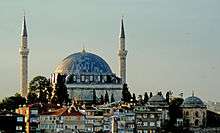Cemile Sultan
Cemile Sultan (Ottoman Turkish: جمیله سلطان; 17 August 1843 – 26 February 1915) was an Ottoman princess, the daughter of Sultan Abdulmejid I and Düzdidil Kadın. She was the half sister of Sultans Murad V, Abdul Hamid II, Mehmed V, and Mehmed VI.
| Cemile Sultan | |
|---|---|
 The burial place of Cemile Sultan is located inside the courtyard of Yavuz Sultan Selim Mosque in Istanbul. | |
| Born | 17 August 1843 Old Beylerbeyi Palace, Constantinople, Ottoman Empire (now Istanbul, Turkey) |
| Died | 26 February 1915 (aged 71) Erenköy Palace, Istanbul, Ottoman Empire |
| Burial | Yavuz Selim Mosque, Istanbul |
| Spouse | Mahmud Celaleddin Pasha |
| Issue |
|
| Dynasty | Ottoman |
| Father | Abdulmejid I |
| Mother | Düzdidil Kadın |
| Religion | Sunni Islam |
Early life
Cemile Sultan was born on 17 August 1843 in the Old Beylerbeyi Palace.[1][2] Her father was Sultan Abdulmejid I, and her mother was Düzdidil Kadın, the daughter of Şıhım Bey Dişan. In 1845, Düzdidil Kadın, died leaving Cemile Sultan motherless at the age of two. Abdulmejid took her to another of his wives, Perestu Kadın, and entrusted her into the lady's care. She grew up together with her half brother Abdul Hamid II, who was also adopted by Perestu, in the same household and spend their childhoods with one another.[3]
In accordance with this tradition, Cemile Sultan started to learn the Quran on 20 September 1847 with her half-sisters Fatma Sultan, her sister Refia Sultan, her brother Murad V and her brother Abdul Hamid II. [4]
Marriage
In 1854, at the age of eleven, Abdulmejid betrothed her to Mahmud Celaleddin Pasha, the son of the Imperial son-in-law, Damat Ahmed Fethi Pasha,[5] and his wife Ayşe Şemsinur Hanım. Fethi Pasha had himself been married to Cemile's aunt, Atiye Sultan. The wedding took place on 17 May 1858, and was consummated on 11 June 1858. The couple were given a palace at Findiklı as their residence.[6] At her marriage, her mother-in-law presented Nazikeda Kadın, who would later become first wife of Sultan Abdul Hamid II to her.[7]
The together had two sons Sultanzade Ibrahim Sakıb Bey and Sultanzade Mehmed Mahmud Celaleddin Bey, and three daughters, Fethiye Hanımsultan, Fatma Hanımsultan and Ayşe Sıdıka Hanımsultan.
The couple supported Abdul Hamid's accession to the throne, until the new Sultan's mistrust of Mahmud Celaleddin Pasha led to the latter's exile to Arabia in 1881, where he was strangled in 1884. Princess Cemile withdrew from society for some twenty years, afterwards reconciling with her brother and paying calls again at the palace.[8]
Character
On ceremonial occasions Cemile Sultan took precedence as she was the eldest, and always took her place at Abdul Hamid's right. A large armchair was reserved for her on the right-hand side, where she took a seat. In processions she walked at the side of Perestu Kadın, ahead of everyone else.[5]
She always wore brown-colored dresses and on her head a hotoz of the same color, fashioned of lace or tulle. She dressed in the Turkish style, with a long train fastened to her waist. Since the sumptuous fabrics she wore were always various shades of brown, this color served as something of a hallmark for her. She wore no jewels whatsoever. Despite this simplicity, her imperial bearing amply conveyed her rank of princess.[5]
Those in a position to know said that she looked just like her father, and indeed from the photographs the eyes and the features are the same. Everyone in the palace felt great respect and fondness for Princess Cemile, holding her in affectionate system. She spoke so graciously and intelligently, not laughing when it was not called for, and exhibiting toward everyone the appropriate conduct due him or her.[5]
Death
Cemile Sultan died at Erenköy, Istanbul on 26 February 1915 and was buried in the mausoleum of her father, Sultan Abdulmejid.[9][10]
Issue
Together with Mahmud Celaleddin, Cemile had five children:
- Fethiye Hanımsultan (c. 1859, Fındıklı Palace – 11 August 1887, Beşiktaş), married without issue;
- Sultanzade Mahmud Celaleddin Bey (c. 1864, Fındıklı Palace – c. 1916, Kandilli Palace), married and had issue;
- Sultanzade İbrahim Sakıb Bey (c. 1864, Fındıklı Sarayı - c. 1897, Kanlıca Sarayı), married and had issue;
- Ayşe Sıdıka Hanımsultan (c. 1875, Fındıklı Palace – c. 1938, Nice, France), married and had issue;
- Fatma Hanımsultan (c. 1879, Fındıklı Sarayı – c. 1890);
See also
In popular culture
- In the 2017 TV series Payitaht: Abdülhamid, Cemile Sultan is portrayed by Turkish actress Devrim Yakut.
Ancestry
| Ancestors of Cemile Sultan | |||||||||||||||||||||||||||||||||||||||||||||||||||||||||||||||||||||||||||||||||||||||||||||||||||||||||||||||||||||||||||||||||||||||||||||||||||||||||||||||||||||||||||||||||||||||||||||||||||||||||||||||||||||||||||||||||||||||||||||||||||||||||||||||||||||||||||||||||||||||||||||||||||||||||||||||||||||||||||||||||||||||||||||||||||||||||||||||||||||||||||||||||||||||||||||||||||||||||||||||||||||||||||||||||||||||||||||||||||||||||||||||||||||||||||||||||||||||||||||||||||||||||||||||||||||||||||||||||||||||||||||||||||||||||||||
|---|---|---|---|---|---|---|---|---|---|---|---|---|---|---|---|---|---|---|---|---|---|---|---|---|---|---|---|---|---|---|---|---|---|---|---|---|---|---|---|---|---|---|---|---|---|---|---|---|---|---|---|---|---|---|---|---|---|---|---|---|---|---|---|---|---|---|---|---|---|---|---|---|---|---|---|---|---|---|---|---|---|---|---|---|---|---|---|---|---|---|---|---|---|---|---|---|---|---|---|---|---|---|---|---|---|---|---|---|---|---|---|---|---|---|---|---|---|---|---|---|---|---|---|---|---|---|---|---|---|---|---|---|---|---|---|---|---|---|---|---|---|---|---|---|---|---|---|---|---|---|---|---|---|---|---|---|---|---|---|---|---|---|---|---|---|---|---|---|---|---|---|---|---|---|---|---|---|---|---|---|---|---|---|---|---|---|---|---|---|---|---|---|---|---|---|---|---|---|---|---|---|---|---|---|---|---|---|---|---|---|---|---|---|---|---|---|---|---|---|---|---|---|---|---|---|---|---|---|---|---|---|---|---|---|---|---|---|---|---|---|---|---|---|---|---|---|---|---|---|---|---|---|---|---|---|---|---|---|---|---|---|---|---|---|---|---|---|---|---|---|---|---|---|---|---|---|---|---|---|---|---|---|---|---|---|---|---|---|---|---|---|---|---|---|---|---|---|---|---|---|---|---|---|---|---|---|---|---|---|---|---|---|---|---|---|---|---|---|---|---|---|---|---|---|---|---|---|---|---|---|---|---|---|---|---|---|---|---|---|---|---|---|---|---|---|---|---|---|---|---|---|---|---|---|---|---|---|---|---|---|---|---|---|---|---|---|---|---|---|---|---|---|---|---|---|---|---|---|---|---|---|---|---|---|---|---|---|---|---|---|---|---|---|---|---|---|---|---|---|---|---|---|---|---|---|---|---|---|---|---|---|---|---|---|---|---|---|---|---|---|---|---|---|---|---|---|---|---|---|---|---|---|---|---|---|---|---|---|---|---|---|---|---|---|---|---|---|---|---|---|---|---|---|---|---|---|---|---|---|---|---|---|---|---|---|---|---|---|---|---|---|---|---|---|---|---|---|---|---|---|---|---|---|---|---|---|---|---|---|---|---|---|---|---|---|---|---|---|---|---|---|---|---|---|---|---|---|---|---|---|---|---|---|---|---|---|---|---|---|---|---|---|---|---|---|---|---|---|---|---|---|---|---|---|---|---|---|---|---|---|---|
| |||||||||||||||||||||||||||||||||||||||||||||||||||||||||||||||||||||||||||||||||||||||||||||||||||||||||||||||||||||||||||||||||||||||||||||||||||||||||||||||||||||||||||||||||||||||||||||||||||||||||||||||||||||||||||||||||||||||||||||||||||||||||||||||||||||||||||||||||||||||||||||||||||||||||||||||||||||||||||||||||||||||||||||||||||||||||||||||||||||||||||||||||||||||||||||||||||||||||||||||||||||||||||||||||||||||||||||||||||||||||||||||||||||||||||||||||||||||||||||||||||||||||||||||||||||||||||||||||||||||||||||||||||||||||||||
References
- Uluçay 2011, p. 221.
- Sakaoğlu 2008, p. 618.
- Brookes 2010, p. 134.
- Kolay 2017, p. 681.
- Brookes 2010, p. 142.
- Sakaoğlu 2008, p. 619.
- Brookes 2010, p. 286.
- Brookes 2010, p. 279.
- Uluçay 2011, p. 224.
- Sakaoğlu 2008, p. 622.
Sources
- Uluçay, Mustafa Çağatay (2011). Padişahların kadınları ve kızları. Ankara, Ötüken.
- The Concubine, the Princess, and the Teacher: Voices from the Ottoman Harem. University of Texas Press. 2010. ISBN 978-0-292-78335-5.
- Sakaoğlu, Necdet (2008). Bu mülkün kadın sultanları: Vâlide sultanlar, hâtunlar, hasekiler, kadınefendiler, sultanefendiler. Oğlak Yayıncılık. ISBN 978-9-753-29623-6.
- Kolay, Arif (2017). Osmanlı Saray Hayatından Bir Kesit: Ali Akyıldız ve Mümin ve Müsrif Bir Padişah Kızı Refia Sultan.
